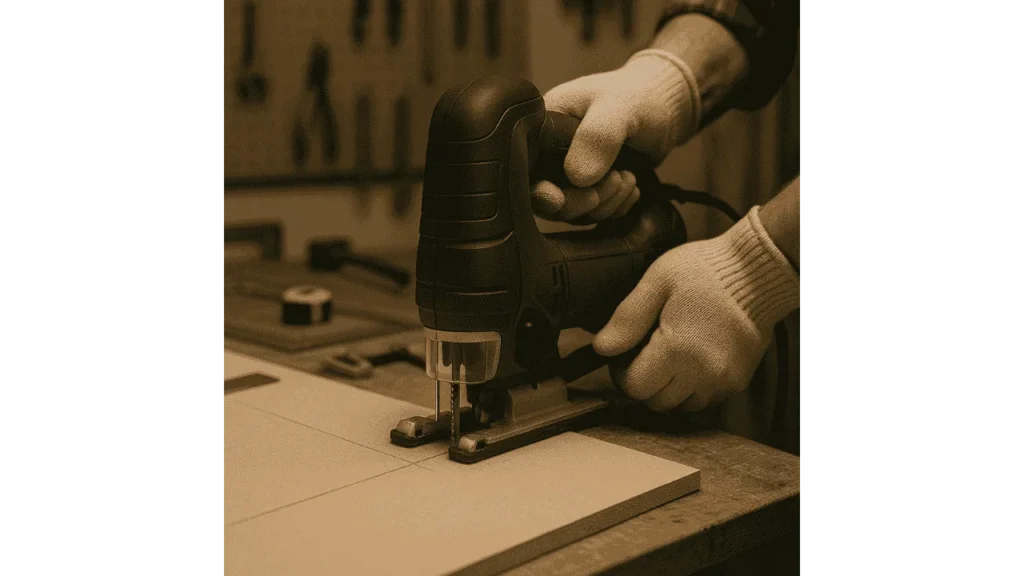A jigsaw is one of the most adaptable power tools you can own. As an expert who has relied on this tool countless times, I can say it’s powerful enough for straight cuts yet delicate enough to handle curves, intricate shapes, and plunge cuts. Let’s learn how to use a jigsaw and what its uses are. Along the way, we’ll explore essential jigsaw techniques and highlight common jigsaw applications, so you feel confident putting it to work in your own projects.

How to Use a Jigsaw Effectively?
Step-by-Step Usage Guide
Prepare Your Tool and Workspace
Start by preparing your tool and workspace. Always select the right blade for your material and unplug or switch off the jigsaw before installing it. Secure your workpiece firmly with clamps and mark your cutting line with a pencil for accuracy.
Starting the Saw & Beginning the Cut
When you’re ready, place the shoe flat on the material, ensuring the blade is not touching it yet. Begin cutting at a slow speed, gradually increasing as you move forward. Ease the blade into the material with gentle forward pressure, allowing the jigsaw to do the work rather than forcing it.
“A jigsaw works best when you guide it, not when you push it. Let the blade cut at its own pace, and your results will be smoother every time.” – Paul Sellers, Woodworking Teacher
Navigating Curves, Internal Cuts, and Plunge Techniques
For internal cuts, drill a starter hole large enough to fit the blade through, then guide the jigsaw carefully along your marked line. When cutting tight curves, make relief cuts short cuts leading into the waste area to prevent the blade from binding. This makes steering the saw easier and keeps your cut cleaner.
Speed Control & Quality Cuts
Adjust the speed settings depending on the material and type of cut. Use slower speeds for curves, plastics, or soft materials, and higher speeds for straighter cuts in wood. Achieving quality cuts is about combining blade speed, feed rate, and pressure consistently so the blade moves smoothly through the material.
Finishing Up Safely
When you’re done, turn off the jigsaw, unplug it or remove the battery, and let the blade cool before handling. Wipe down the blade, clear the work area of dust or debris, and store your jigsaw in a safe, dry place. A little post-use care extends the life of your tool and keeps it ready for the next project.
What Are the Uses of a Jigsaw?
Versatile Cutting Applications
The jigsaw’s design makes it perfect for cutting curves, circles, and irregular shapes across a variety of materials, including wood, laminate, plastic, metal, and even ceramic. With the right blade, it transitions smoothly from one material to another, making it a true all-in-one cutter for many jobs.
“If there’s one saw that earns its keep in every workshop, it’s the jigsaw. From plywood to pipe, its adaptability is unmatched.” – Norm Abram, Master Carpenter
Common & Creative Projects
A jigsaw comes in handy for many everyday and creative projects. It’s excellent for making internal cutouts, such as starter holes for electrical outlets or air vents. You can use it for notches and edge detailing in cabinetry or custom furniture, and for decorative trim or template work. With the right blade, it handles plastics, tiles, and laminates with ease. It’s also well-suited for plunge cuts and stencil tracing, making it a go-to tool for both small-scale DIY tasks and detailed artistic woodworking.
Final Takeaways
“Master the basics of your jigsaw and it will quickly become one of the most valuable tools you own.” – Steve Ramsey, Woodworking Educator
You’ve now learned both how to use a jigsaw step-by-step and what it can be used for. From its ability to handle complex curves to its convenience in cutting multiple materials, this tool is as versatile as it is reliable. Its portability means you can take it wherever the project demands, while its control allows you to handle precise work with confidence. Now that you know how to use a jigsaw and what its main uses are, you can confidently select the right blade, technique, and project to harness its full potential.
- How to Cut a Straight Line with a Jigsaw? - October 31, 2025
- How to Cut a Circle with a Jigsaw? - October 31, 2025
- Can You Cut Acrylic with a Jigsaw? - October 31, 2025
